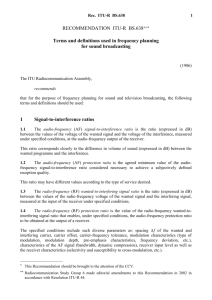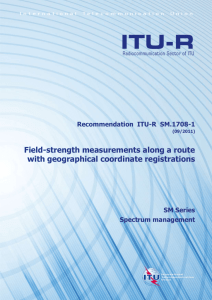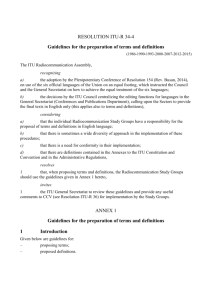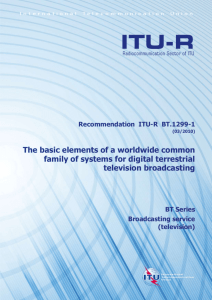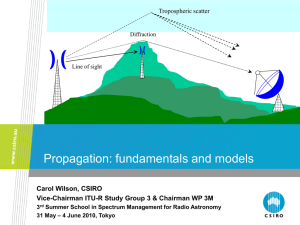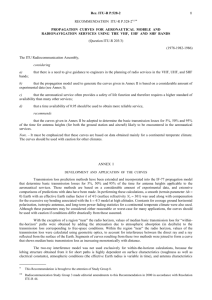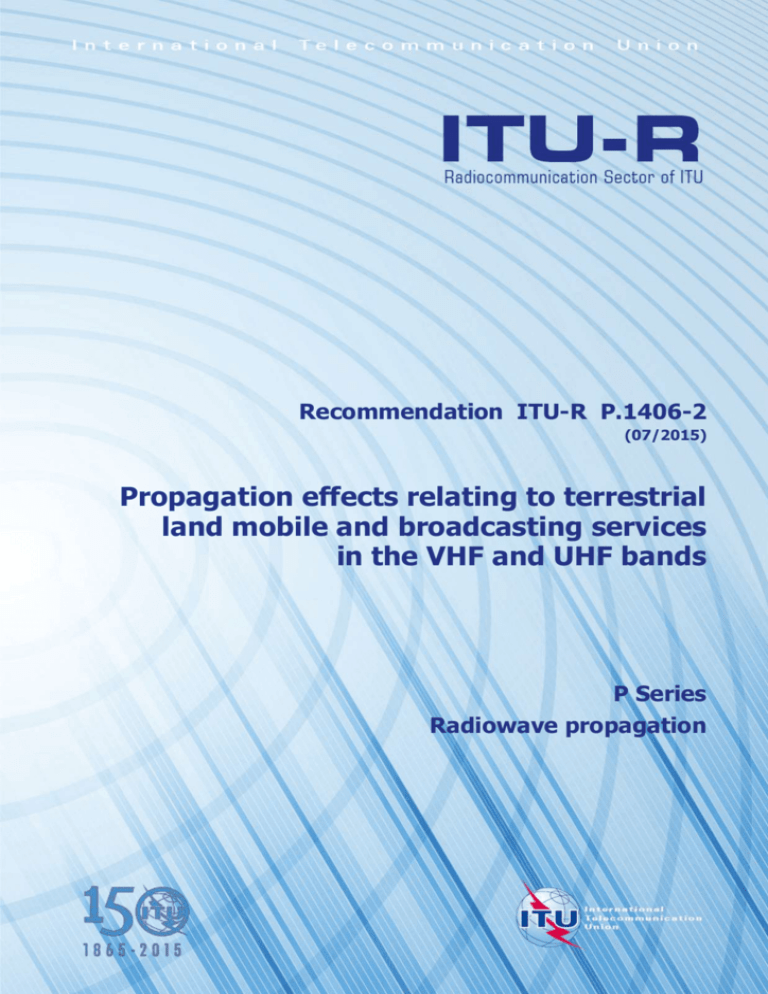
Recommendation ITU-R P.1406-2
(07/2015)
Propagation effects relating to terrestrial
land mobile and broadcasting services
in the VHF and UHF bands
P Series
Radiowave propagation
ii
Rec. ITU-R P.1406-2
Foreword
The role of the Radiocommunication Sector is to ensure the rational, equitable, efficient and economical use of the
radio-frequency spectrum by all radiocommunication services, including satellite services, and carry out studies without
limit of frequency range on the basis of which Recommendations are adopted.
The regulatory and policy functions of the Radiocommunication Sector are performed by World and Regional
Radiocommunication Conferences and Radiocommunication Assemblies supported by Study Groups.
Policy on Intellectual Property Right (IPR)
ITU-R policy on IPR is described in the Common Patent Policy for ITU-T/ITU-R/ISO/IEC referenced in Annex 1 of
Resolution ITU-R 1. Forms to be used for the submission of patent statements and licensing declarations by patent
holders are available from http://www.itu.int/ITU-R/go/patents/en where the Guidelines for Implementation of the
Common Patent Policy for ITU-T/ITU-R/ISO/IEC and the ITU-R patent information database can also be found.
Series of ITU-R Recommendations
(Also available online at http://www.itu.int/publ/R-REC/en)
Series
BO
BR
BS
BT
F
M
P
RA
RS
S
SA
SF
SM
SNG
TF
V
Title
Satellite delivery
Recording for production, archival and play-out; film for television
Broadcasting service (sound)
Broadcasting service (television)
Fixed service
Mobile, radiodetermination, amateur and related satellite services
Radiowave propagation
Radio astronomy
Remote sensing systems
Fixed-satellite service
Space applications and meteorology
Frequency sharing and coordination between fixed-satellite and fixed service systems
Spectrum management
Satellite news gathering
Time signals and frequency standards emissions
Vocabulary and related subjects
Note: This ITU-R Recommendation was approved in English under the procedure detailed in Resolution ITU-R 1.
Electronic Publication
Geneva, 2015
ITU 2015
All rights reserved. No part of this publication may be reproduced, by any means whatsoever, without written permission of ITU.
Rec. ITU-R P.1406-2
1
RECOMMENDATION ITU-R P.1406-2
Propagation effects relating to terrestrial land mobile and
broadcasting services in the VHF and UHF bands
(Question ITU-R 203/3)
(1999-2007-2015)
Scope
This Recommendation provides information on various aspects of propagation which are likely to affect the
terrestrial land mobile and broadcasting services. These aspects should be taken into account in the design
and planning of such services.
The ITU Radiocommunication Assembly,
considering
a)
that there is a need for information on aspects of propagation likely to affect terrestrial land
mobile and broadcasting services,
noting
that Recommendation ITU-R P.2040 provides guidance on the effects of building material
properties and structures on radiowave propagation,
recommends
1
that the information contained in Annex 1 should be taken into account in the design and
planning of such services.
Annex 1
1
Introduction
This Recommendation provides information on various aspects of propagation which are likely to
affect the terrestrial land mobile and broadcasting services. These aspects should be taken into
account in the design and planning of such services.
2
Attenuation due to land cover
These losses are likely to be of great importance for the land mobile service. They will depend on
the category of the terrain, the extent of vegetation, and on the location, density and height of
buildings. Table 1 summarizes the applicability of the various available ITU-R Recommendations:
2
Rec. ITU-R P.1406-2
TABLE 1
Recommendations discussing land cover
ITU-R P.
Applicability
1546
Antenna height corrections
452
Clutter losses
833
Attenuation in vegetation (especially trees)
1058
Terrain databases
1146
Antenna height corrections
1812
Vegetation and clutter losses
1238
Planning of indoor radiocommunication systems
2040
Effects of building materials and structures
3
Signal strength variability
3.1
General
The strength of the signal received will vary with both time and location. The signal may be
composed of direct, diffracted, reflected, and refracted components. The quality of the reception
will depend upon several factors such as the receiving environment, frequency shifts, time delays,
and type of modulation. Similarly, unwanted transmissions may also be received from other sources
sharing the same frequencies as, or adjacent frequencies to, the wanted signal. These, too, will have
to be taken into account in assessing the quality of service. These unwanted transmitters may be so
distant from the receiver that the extent of the temporal variation created by the various forms of
abnormal propagation will need to be quantified. This may involve a situation in which the risk of
interference has to be accepted for a defined percentage of time at various receiving locations in
order to allow the network(s) to operate.
In summary, the assessment of reception and the definition of the service area involve the analysis
of wanted and unwanted signals in both time and location domains, and the extent of the correlation
between them.
3.2
Fading regimes
A reduction in signal strength occurs when the receiver is in the shadow of trees or buildings or of
terrain obstacles or other objects. The signal then arrives at the receiver after being diffracted over
or around these obstacles, or being reflected from other objects. If the size and shape of the
obstacles are known, an attempt can be made to calculate from theory the additional path loss that
they create. Otherwise, if only general information about the environment is available, an estimate
of path loss can be made from measurements made in similar situations. In any case, on a
sufficiently small scale, a theoretical estimate will not be possible, and an estimate based on
measurements will be necessary. Such an estimate must be statistical in nature. Typically, it consists
of a median path loss for a specified area, and a measure of its variance.
The signal may vary explicitly with time because of atmospheric variations, but over distances of
less than about 50 km, this kind of variation is relatively unimportant. More important in the land
mobile service is spatial variability, which is seen as time variability by a moving receiver.
It is convenient to divide spatial variability into two regimes, rapid fading due to multipath, which
occurs on the scale of a few wavelengths, and slower fading due to changes in shadowing.
In analysing measurements, the two can be separated in the following way: a number of
Rec. ITU-R P.1406-2
3
measurements should be made at equal intervals over a distance of about 40 wavelengths, and a
median signal level or path loss found for this distance. About 36 such measurements are required
to obtain a median accurate to within 1 dB with 90% probability. The distance between
measurements should be at least 0.8 of a wavelength in order for adjacent measurements to be
uncorrelated, a criterion that is satisfied with the conditions just given. This procedure is repeated
for other distance intervals of 40 wavelengths until the area of interest is covered. Experience has
shown that the distribution of these median values will be log-normal, and therefore their
distribution can be characterized by their mean or median, and their standard deviation. This is the
distribution of signal strength variations due to shadowing, with the multipath variation removed.
3.2.1
Shadowing
A number of measurements have been made of signal-strength distribution due to shadowing. It is
important to specify whether the area of interest is a large one, i.e. all paths of a given length around
a base transmitter or all paths of a given length in a geographical region; or a small one, i.e. an area
of dimensions of a few hundred metres over which the path profile and the general environment of
the receiver do not change significantly. The signal variability will be greater in a large area than in
a small one.
In rural areas, for all paths of a given length the standard deviation, L, of the location variability
distribution may be estimated by:
1/ 2
h
L 6 0.69
L 25
dB
h
– 0.0063
dB for h/ 3 000
(1)
for h/ 3 000
where:
h:
:
wavelength (m)
f:
300/f
frequency (MHz).
interdecile height variation (m)
In flat urban areas, the standard deviation over a large area may be estimated by:
L 5.25 + 0.42 log (f /100) + 1.01 log2 (f /100)
dB
(2)
valid from 100 MHz to 3 000 MHz.
The standard deviation of location variability over small areas is less well-known. It is thought to
depend on land cover, but it is not clear what that dependence is. There is some evidence that the
standard deviation decreases with increasing distance from the transmitter, but this is not always
clear. A formula (3) roughly summarizes some measurements at UHF for distances up to 50 km and
all types of land cover, and which retains the frequency dependence of the formula (2), is:
L 2.7 + 0.42 log (f /100) + 1.01 log2 (f /100)
dB
(3)
A different empirical expression for such shadow fading is given in Recommendation
ITU-R P.1546.
4
3.2.2
Rec. ITU-R P.1406-2
Multipath fading
On a scale of a few wavelengths, signal variability is determined by multipath effects. As a
minimum, it is to be expected that a ground reflected component will be present, and as a
consequence, multipath effects are always observed in practice. Such multipath effects generally
lead to the classification of a channel as being “Rayleigh” or “Ricean”.
In the former case the received signal is the sum of many independently fading components, and
can be represented by the Rayleigh distribution (see Recommendation ITU-R P.1057). Such a
channel would be typical for a narrow band cellular mobile service operating in a cluttered urban
environment, with no line-of-sight to the transmitter.
The Ricean channel is associated with the situation where one of the components of the received
signal, such as that associated with a line-of-sight path to the transmitter, has a power that is
constant on the timescale of the multipath fading. In this case, the overall signal fading can be
modelled by the Nakagami-Rice distribution (see Recommendation ITU-R P.1057). This
distribution is often formulated in terms of the parameter, K (the “Rice factor”) which is defined as
the ratio between the power in the constant part of the signal and that in the random part. For K = 0,
the distribution becomes Rayleigh.
3.3
Local reflections
Radiowaves arriving at a mobile receiver may be reflected from the ground and from nearby objects
such as buildings, trees and vehicles. The ground-reflected wave is coherent with the direct wave
and causes the received signal to vary with receiver antenna height. However, waves reflected from
nearby objects have random amplitudes and phases.
Constructive and destructive interference between the direct and various reflected waves creates an
interference pattern in which the distance between minima is at least one half wavelength.
In urban or forested areas, there are many reflected waves, and the instantaneous field strength
when measured over distances of a few tens of wavelengths follows approximately a Rayleigh
distribution.
The interference pattern gives rise to fast fading in a moving receiver, and reflections from moving
vehicles can cause fading even in a stationary receiver.
Fades of 30 dB or more below the mean level are common.
Local reflections can also have the beneficial effect of filling in deep shadows to some degree.
3.4
Signal correlation
The correlation in mean received power from different sources is important for the evaluations of
carrier to interference ratio, C/I.
Consider C as the desired carrier power (dB) with a mean Cm and a standard deviation C and I as
the power (dB) from one interfering source with a mean Im and a standard deviation I then the
mean C/I-ratio (C/I)m, becomes:
(C/I)m = Cm – Im
dB
(4)
which is independent of the correlation.
The standard deviation of the C/I ratio, C/I, becomes:
C/I C2 2I 2C I
(5)
Rec. ITU-R P.1406-2
5
where is the correlation coefficient. In the case of I C, equation (5) simplifies to:
C/I 2(1 )
(6)
The correlation coefficients derived from sample sets of received power data indicate that for
reception from opposite directions no significant correlation is evident. When the angle of arrival
difference at the mobile is small, significant correlations exist. Typical values of for co-sited
sources are 0.8 to 0.9 in farmed and heavily wooded areas. In metropolitan areas the correlation is
generally lower ( between 0.4 and 0.8). Usually correlations in mountainous areas are very low.
However, values of 0.8 are observed in exceptional situations even in mountainous areas.
4
Delay spread
Many types of radio system, particularly those using digital techniques, are sensitive to multipath
propagation introduced to the signal by the path characteristics. After the arrival of the direct signal,
a number of reflected signals arrive causing this phenomenon. Based on the amplitudes and time
delays of these signals a channel impulse response (CIR) can be derived. Several parameters
describing the propagation channel can be extracted from the CIR, see Recommendation
ITU-R P.1407.
One of the important parameters is r.m.s. delay spread, S, as given in equations (3) and (4) of
Recommendation ITU-R P.1407. A useful measure of the extent of time spread is the multipath
delay spread, Tm, where:
Tm = 2 S
(7)
Which of the parameters discussed above are most useful in predicting system performance is
dependent upon the particular modulation scheme involved.
4.1
Impact on system performance
Depending on the ratio between delay spread and symbol duration, different phenomena are
responsible for the bit error ratio. Multipath signals yield a rapid phase variation in space and
frequency. For modulation schemes using some sort of angular modulation, e. g. differential phase
shift keying (DPSK), these phase variations are responsible for the so-called irreducible errors,
which remain, even at large signal-to-noise ratios. As long as the delay spread is smaller than the
symbol duration, the irreducible errors depend more on the delay spread than on the exact shape of
the impulse response. However, if the delay spread exceeds the symbol duration, intersymbol
interference occurs, which depends more on the CIR shape.
4.2
Delayed signals due to local scatterers
Signals with short delays are often observed in areas with a uniform distribution of local scatterers.
Such signals typically occur in urban or suburban areas, where no line-of-sight situations to large
reflectors at longer distances (mountains, hills) exist. The uniform distribution of the scattered
signals usually yields homogeneous impulse responses, (see also Recommendation ITU-R P.1238).
In addition to the homogeneous portion of the impulse response, strong echoes from large buildings
are sometimes identified resulting in an inhomogeneous impulse response. Furthermore,
inhomogeneous impulse responses are observed at street intersections.
Typical values of r.m.s. delay spread observed in urban and suburban areas are in the range of
0.8 s to 3 s. For high-data rate systems a more detailed knowledge of the impulse response may
be necessary. The corresponding detailed signal strength calculation for the multipath signals
6
Rec. ITU-R P.1406-2
incorporates ray-tracing or ray-launching techniques in conjunction with the application of highresolution building data.
4.3
Delayed signals due to large distant scatterers
Signals with long delays typically occur in areas where mountains near to a flat area, such as a plain
or a valley. This effect is particularly evident where there is a large flat area adjacent to a single
range of mountains, reducing the possible mitigating effects of other mountain ranges. Typical
values have been observed up to about 25 s.
The strength of the direct signal should be calculated by the appropriate method, as determined by
Recommendation ITU-R P.1144 over the limits of validity defined in that Recommendation. The
strength of reflected signals can be calculated from the formula (8):
2
Pt Gt Gr
Acos 1cos 2
Prs
323 r1r2
(8)
where:
Prs :
power of the received signal
Pt :
transmitter power output
Gt :
effective transmitter antenna gain (including line- and filtering-losses)
Gr :
effective receiver antenna gain (including line- and filtering-losses)
:
r1 , r2 :
:
A:
1, 2 :
wavelength in the same units as r1 and r2
distances from the scattering plane (mountain surface) to the transmitter and to
the receiver
reflectivity of the scattering plane
area of the scattering plane in same units (squared) as r1 and r2
acute angles that the normal to the scattering plane makes with the rays to the
transmitter and to the receiver.
The above formula (8) does not consider the vertical angle but it should be sufficiently accurate for
land mobile work. It should also be pointed out that this formula will be less accurate in the
presence of ducts and other refractive phenomena. In extreme cases it may not be applicable at all
because a reflector that would normally be considered is no longer within radio line-of-sight or,
conversely, where a mountain side that is normally outside line-of-sight is brought into line-of sight.
For simplicity and speed of calculation, each mountain range is considered to be a single scattering
plane with the same azimuthal orientation as that of the crest of the range. The area, A, is the area of
the portion of the range that is within the half-power antenna beamwidths of both the transmitting
and receiving antennas and is not shadowed from either antenna. The parameters r1, r2, 1, and 2
are calculated from the centre of the aforementioned portion of the mountain range.
If a portion of a reflecting mountain range is shadowed from either the transmitting or receiving
station by a closer mountain range such that the reflective area of the farther range is separated into
sections, the calculation is done by considering the unshadowed portions as separate mountain
ranges. This concept is shown in Fig. 1.
The reflectivity, , has been observed to have values between 0.001 and 0.2 (–30 dB and –7 dB).
For forested mountains, the reflectivity is unlikely to exceed 0.05 (–13 dB). For bare mountains, the
reflectivity would be unlikely to exceed 0.2 (–7 dB).
Rec. ITU-R P.1406-2
7
Any clutter losses applied to the direct signal calculation should also be applied to the reflected
signal calculation.
FIGURE 1
Modelling of direct and reflected signals
Model
as
P.1406-01
5
Antenna effects
5.1
Polarization effects
5.1.1
Depolarization phenomena in the land mobile environment
In the land mobile environment some or all of the transmitted energy may be scattered out of the
original polarization due to diffraction and reflection of the radiowave. It is convenient to take this
depolarization effect into consideration by using a cross-polarization discrimination (XPD) factor,
as defined in Recommendation ITU-R P.310.
XPD measurements at 900 MHz show that:
–
XPD depends little on distance;
–
the average XPD in urban and residential areas ranges from 5 dB to 8 dB, and is over 10 dB
in open areas;
–
the average correlation between vertical and horizontal polarization is 0.
XPD increases with decreasing frequency, to about 18 dB at 35 MHz.
XPD is log-normally distributed with a standard deviation somewhat dependent on the frequency.
The average value of the difference between the 10% and 90% values (in the frequency range
30 MHz to 1 000 MHz) is about 15 dB. Whether the original polarization is vertical or horizontal
has been observed to make only a slight difference in this respect.
Two types of time variation of the depolarization effect have been found. The first is a slow
variation resulting from the changing electrical properties of the ground with weather conditions.
This effect is most pronounced at lower frequencies. The second is due to the motion of trees which
gives a depolarization fading phenomenon amounting to several decibels in amplitude at quite
moderate wind velocities.
5.1.2
Polarization diversity
Because of the considerable amount of scattering in urban and residential areas, and the consequent
low values of XPD, polarization diversity may be a useful technique for improving reception. The
most basic option would be the use of two orthogonal linear polarizations at the base station.
8
Rec. ITU-R P.1406-2
As an alternative to diversity, circular polarization at the base station and linear polarization at the
mobile terminal, while resulting in a 3 dB polarization mismatch, can take advantage of the
depolarization due to scattering and provide a more constant received signal level in the mobile
environment.
5.2
Height gain: base and mobile
Height gain refers to a change in received signal strength with antenna height. Although usually
increasing with height (positive height gain), it can also decrease with height (negative height gain).
In the absence of local clutter, the direct signal can interact with a ground reflected ray from the
same transmitter. The resulting field strength variation, in a vertical direction, is a series of maxima
and minima as the path geometry causes the two signals to go in and out of phase.
In practice, particularly with mobile receivers, clutter and other reflected signals tend to minimize
this two-ray effect and above 200 MHz it can be neglected in most situations. Instead, it is usually
found that raising the antenna simply reduces the effective clutter loss causing the received signal to
increase with height. Since antenna height is related to clutter loss in this way, this form of height
gain can be categorized in terms of the type of ground cover as in Recommendation ITU-R P.370.
In other prediction methods, especially those which use a terrain data base, antenna height is
frequently linked directly to the calculation of clutter loss.
For base stations, operating at frequencies below 200 MHz and located in open areas, 2-ray effects
can sometimes be found so that re-positioning of the antenna may be required to avoid negative
height gain. Such an effect is difficult to predict precisely, since a detailed knowledge of the terrain
profile at the reflection point is required. Above 200 MHz, due to the smaller wavelength, this
particular problem tends to diminish and at UHF and above it can be ignored.
5.3
Correlation/space diversity
Space diversity is practical for antennas having cross-correlations up to about 0.7. In general, this
makes portable and mobile diversity reception nearly impractical. For the base station case,
however, a number of techniques are possible for reducing the cross-correlation between antennas.
The two most practical are vertical and horizontal separation.
To reduce the cross-correlation to 0.7 or less, vertically spaced antennas must be separated by
approximately 17 wavelengths or more. Horizontal separation can be more effective, depending
upon the relative orientations of the plane of the antennas versus the direction of motion of the
mobile. If the vertical plane through the antennas is perpendicular to the direction of motion of the
mobiles, the cross-correlation will be approximately the same as that for the vertical separation
case. With optimum orientation, horizontal antennas can be separated by as little as 8 wavelengths.
It should be borne in mind that nearly optimal orientations can be maintained only in special cases,
such as systems using sectored antennas.
5.4
Realisable vehicular mobile antenna gain
Since vehicular mobile stations usually operate in a multipath environment, it is not surprising that
mobile antenna gain will not, in most cases, match that measured on the pattern range. Additionally,
even in line-of-sight non-multipath conditions, the vertical angle of arrival is not necessarily
horizontal. In fact, practical cases exist where the vertical angle of arrival can exceed 10. In the
latter case, the vertical angle of arrival could easily be on a null or a minor lobe, rather than the
main lobe of the mobile antenna’s vertical pattern.
Tests measuring mobile antennas rated at 3 dB and 5 dB gain relative to a /4 vertical monopole in
practical situations have shown that their practical gain values rarely meet the values measured on
an antenna range. In multipath situations or in clear situations with high angles of arrival (2), the
Rec. ITU-R P.1406-2
9
practical gain of either antenna is approximately 1.5 dB relative to a /4 vertical monopole over a
distance range up to at least 55 km. In clear situations with low elevation angles, full gain may be
realisable.
6
Portable effects
6.1
Building entry loss
Propagation losses incurred through entering a building can vary considerably depending on the
type of building and the construction materials. The frequency of the signal and its angle of
incidence are also significant. Consequently, loss values can range from a few to many tens of
decibels.
Recommendation ITU-R P.2040 provides information on the losses encountered by radio signals
entering or leaving buildings. Once inside a building, further losses can be incurred due to its
internal construction and contents, and this aspect is dealt with in Recommendation ITU-R P.1238.
6.2
Body loss
The presence of the human body in the field surrounding a portable transceiver, cellular phone, or
paging receiver can degrade the effective antenna performance – the closer the antenna to the body
the greater the degradation. The effect is also frequency dependent as shown in Fig. 2, which is
based on a recent detailed study on portable transceivers at four commonly used frequencies.
FIGURE 2
Typical body loss – Portable transceiver
Median body loss (dB)
20
10
0
2
2
10
5
3
10
Frequency (MHz)
Waist level
Head level
P.1406-02
10
Rec. ITU-R P.1406-2
It is not possible to talk exclusively of “body loss” when dealing with paging receivers because a
paging receiver’s antenna is integral to the unit. For that reason, the sensitivity of a paging receiver
is typically specified in terms of field strength (usually in V/m). It is, however, useful to know
how much antenna gain is provided by a typical integral antenna when the pager is worn on the hip.
Table 2 shows those values for a particular pager at three different frequencies.
TABLE 2
Paging receiver gain
7
Frequency
(MHz)
Antenna Gain
(dB)
160
– 25
460
– 22
930
– 19
Guided propagation
Propagation can be viewed as “guided” whenever a wavefront is not free to expand in three
dimensions. Examples include tropospheric ducting, “street-canyon” communications, and
transmission-line technology, particularly waveguides.
Section 7.1 discusses propagation along tunnels which needs to be considered when a radio signal
enters at either end or is launched by an antenna within the tunnel. Section 7.2 discusses the closely
related topic of leaky feeders.
7.1
Propagation in tunnels
Radio systems are typically required in road and rail tunnels for broadcasting and mobile telephone
services, and in mines or other underground facilities for safety and operational reasons.
Propagation within a tunnel having some degree of regularity can be interpreted in terms of
waveguide theory. Depending on frequency, radiowaves will travel along the length of the tunnel in
transverse-electrical (TE) or transverse-magnetic (TM) modes, in which the electrical or magnetic
components, respectively, are only transverse to the tunnel axis. Every mode has a critical
frequency below which it will not propagate. Above its critical frequency each mode propagates
with its own propagation and phase coefficients. The mode with the lowest frequency defines the
waveguide cut-off frequency, below which no practical propagation exists. For a rectangular
waveguide, the cut-off frequency is equivalent to a wavelength of twice the width of the longer side.
For an irregular tunnel, a useful approximation is a wavelength equal to the tunnel cross-section
circumference.
For normal transport or habitable tunnels, radio services at VHF will normally be above the cut-off
frequency, and at UHF well above.
At frequencies well above cut-off, propagation within a tunnel can also be interpreted in terms of
ray theory, and this is generally more appropriate as the wavelength becomes very small compared
to the tunnel cross-section. A tunnel with sides which are smooth compared to the wavelength will
support propagation by wall reflections at grazing angles, at which most materials exhibit high
reflection coefficients. Due to the large variety of reflected paths available, the result has multipath
characteristics, with Rayleigh or Rician fading.
Rec. ITU-R P.1406-2
11
Obstructions in a tunnel will cause radiowaves well above cut-off to be scattered, in general,
through large angles, and will thus interrupt the process of grazing-incidence reflections. A
diffraction loss will be experienced immediately beyond an obstruction due to shadowing.
Specific attenuation rates for propagation through tunnels vary widely, and are particularly affected
by irregularities and changes in tunnel direction, and obstructions, including traffic. In a typical
road tunnel attenuation figures in the range 0.1 to 1 dB/m can be regarded as typical, but values
outside this range can easily exist. Due to the coexistence of multiple modes above the critical
frequency, attenuation rates can either increase or decrease with increasing frequency, depending on
circumstances.
7.2
Leaky feeders
Leaky feeders are often used to overcome obstacles to propagation within a tunnel, and are often the
only practical method of supporting services below cut-off, such as medium-wave broadcasting.
If the radio services to be supported are carried on a coaxial cable mounted along the tunnel length,
and somewhat away from its side, and if the outer-conductor has gaps, some energy will leak
through the outer-conductor as a transverse electro-magnetic (TEM)-type wave between the
coaxial-outer and the tunnel walls. This process is referred to as mode-conversion. Irregularities in
the coaxial-cable/tunnel system, including feeder mountings, will also cause mode-conversion. In
order to control mode-conversion, some systems use sections of non-leaky feeder interspersed with
discrete mode-conversion devices.
The design of leaky-feeder systems is specialized. A practical problem is that the coupling-loss
between a leaky-feeder and mobile terminals is high when the feeder is mounted close to the tunnel
sides, whereas clearance considerations usually prevent mounting far from a side.
8
Temporal variations
The received field strength will vary with time, in addition to location and the nature of the terrain.
The standard deviation of the time variability, t, is given in Table 3.
TABLE 3
Standard deviation t
t
(dB)
Band
d
(km)
50
100
150
175
VHF
Land and sea
3
7
9
11
UHF
Land
2
5
7
Sea
9
14
20
Under certain radio-meteorological conditions, the phenomenon of ducting can occur and may
cause substantial signal increases leading to potential interference (see Recommendation ITU-R
P.452). These effects are intermittent and short term.




